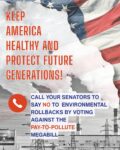- Share on Facebook
- Like
- Digg
- Tumblr
- VKontakte
- Buffer
- Love This
- Odnoklassniki
- Meneame
- Blogger
- Amazon
- Yahoo Mail
- Gmail
- AOL
- Newsvine
- HackerNews
- Evernote
- MySpace
- Mail.ru
- Viadeo
- Line
- Comments
- SMS
- Viber
- Telegram
- Subscribe
- Skype
- Facebook Messenger
- Kakao
- LiveJournal
- Yammer
- Edgar
- Fintel
- Mix
- Instapaper
- Copy Link
- Bluesky
This EPA report below, listed by Ron Burke of ALA in prior email, I believe only demonstrates TDF use in a dual-chambered incinerator equipped with an afterburner.
There’s a big problem with these EPA tests.
The EPA used a small scale state-of-the-art incinerator with all the bells and whistles on it. But these items do not necessarily apply to most of the TDF combustion devices out there like they want to use in your state.
In addition, the vast universe of tens of thousands of standard boilers, heaters, furnaces, cement kilns, etc. are ONLY single chambered combustion devices –not dual chambered units that allow for much improved combustion efficiency–so I hope you understand the importance of this.
Therefore, my opinion is that EPA’s report looks good for dual-chambered, state-of-the-art incinerators, but has some real world limitations in single chambered combustors especially without all the bells and whistles that EPA used.
- Neil Carman, Ph.D.
- Clean Air program Director and former Texas Air Control Board investigator
- Lone Star Chapter of the Sierra Club
“Burning Tires for Fuel and Tire Pyrolysis: Air Implications.” USEPA. 1991. EPA450/3-91-024.
——————-
For one thing, most TDF stack tests I have reviewed do not sample and analyze for the range of air toxics and heavy metals, and these reports should be ignored in comparisons of toxics/metals if the data is not available.
I have obtained several test reports and the raw data often reveals the process fluctuations especially in emissions during the stack performance tests.
You will observe NOx, for example, cycling up and down by large ppm shifts, because cement kilns are very large systems and balancing the kiln’s process conditions is like juggling many parameters at the same time. The NOx fluctuations are not at all reflected in the final averages for, say, a 2-4 hour stack test burning TDF. That means if you only evaluate the final average NOx data, you will not be aware of the significant NOx perturbations taking place according to the test results. Kiln operators may not be aware for several minutes that the kiln is in upset, and so correcting the kiln’s problems takes time to react after-the-fact of what is happening.
I recommend that you ask Kaiser and another cement kiln to give you a plant tour, especially the Control Room to see the process controls and monitoring systems as it is quite complicated. Then it will be all too obvious that these complex processes greatly fluctuate up and down as they cycle through the conditions, although at times you may observe some steady-state periods, but I believe these to be more the exception than the rule (also depending on the type of kiln).
I generally agree that there is a tendency, even here in Texas, to skew the stack test data in favor of burning TDF as showing no statistical difference-to-showing that it burns cleaner than coal such as lower NOx.
One example is an EPA dual-chambered incinerator TDF stack test in the early 1990s that is cited as proving how well TDF burns, but cement kilns/lime kilns/boilers are not dual-chambered combustion systems–but are only single chambered systems.
All modern incinerators (medical, commercial, municipal, commercial-private hazardous, industrial and super-fund units) are basically dual-chambered systems to obtain high combustion efficiencies and using a single combustion chamber for incineration is totally illegal today for the most part. Single chambered incinerators were built in the 1930s-60s, and then dual-chambered units were built to improve combustion.
Dual-chambered incineration is a standard federal and state requirment throughout the US I am sure. Single chambered incinerators have almost all been shut down and observing their stacks will convince anyone why they do not work well enough to protect public health. I am not an advocate of incineration, however, since even the best state-of-the-art units today experience problems of one type or another.
My point is that burning TDF in many cement kilns/lime kilns/boilers means that combustion is occurring only in a single burn chamber. But yet TDF is made of complex materials requiring different combustion conditions such as oxygen, temperature, turbulence and residence times. The extender oils are much higher molecular weight chemicals and will require more oxygen, higher temperatures, longer residence time and more turbulence to burn as efficiently as the styrene-butadiene polymer in the SBR rubber. TDF contains roughly 25% extender oils and when they burn in the open air, that’s what gives tires the ugly black smoke plumes and not the 50% SBR or 25% carbon black.
- Tuesday, December 1, 1998 9:52:50 AM
- From: Jim Kotcon
- Subject: air-mail: Tire incinerators. -Reply
- To: Tom Degen
Tom, A bunch more is coming. The citations below are a little dated, but I ran across a recent EPA study on the web at www.epa.gov/ttncatc1/dir1/tire_eng.pdf that is titled “Air emissions from scrap tire combustion”, EPA-600/R-97-115, from Oct. 1997. They studied air emissions from both open burning of tires as well as “controlled” tire incinerators. I will mail you the Executive Summary, the full report is 117 pages. The bottom line is that air emissions are generally low for controlled burns in 100% tire incinerators with appropriate controls, that industrial boilers, cement kilns, paper mills, etc. can burn up to 20 % tire-dreived fuel if it is shredded and dewired and if they have appropriate particulate controls, e.g., electrostatic precipitators, etc. In results from 22 tire-burning facilities, emissions were generally lower with 10-20 % tire derived fuel than with 100 % coal, wood, or fuel oil. The exception was that higher zinc emissions were consistently observed because zinc tends to be emitted on particles too small to be captured by precipitators. Only two facilities had measurements for dioxins.
A dedicated 100 % tire-fueled boiler with a specially-designed combustor and add-on pollution controls burning 3.5-4 tons per hour produced 0.19 mg/day “dioxins and furans” and 260 mg/day PCBs. ((By comparison, this dioxin emission rate, on a per ton of fuel basis, is on the order of 15 times higher than the projected dioxin air emissions from kraft pulp boilers (the largest sources) at the Apple Grove Pulp and Paper mill. According to the Apple Grove draft air permit, each kraft boiler was to burn more than 100 tons/hour of kraft pulp liquors and would have emitted 0.45 mg/day TEQ.)) None of the other 22 boilers studied reported PCB measurements.
A Univ. of Iowa boiler producing steam for heating produced 1.5 mg/day dioxins on 100 % coal, but only 0.86 mg/day dioxins on 96 % coal and 4 % tires. From these meager results, EPA concluded that burning tires may reduce dioxin emissions from coal-fired power plants. This is good news for tire burners, but bad news for the coal industry because it will highlight the fact that coal burning does produce dioxins. I have seen some data to suggest that diesel fuel is mich worse than coal in producing dioxins, but no direct comparisons were in this report.
By comparison, open burning of tires, as in tire pile fires, is widely acknowledged as extremely hazardous. On the order of 1 % of the weight of the tire is given off as hazardous airpollutants of all kinds. The mutagenicity of tire fire smoke is 13,000 times that of coal-fired power plant emissions.
The EPA report indicated that they had no data on “poorly operated” tire incierators, but concluded that emnissions would likely be much closer to those of an open-burned tire fire than a well-operated incinerator. Even in well-operated incinerators, emissions were likely to exceed standards during “upsets” and in “batch feed” operations, suggesting that standards were easiest to achieve when the incinerator was operating in a smooth continuous feed “steady-state” operation.
- Tuesday, December 1, 1998 10:18:16 AM
- Subject: Letter from Prof. Schwartz to CIWMB 1/21/98
- January 21, 1998
- Mr. Daniel Pennington, Chair
- Mr. Robert Frazee, Vice-chair
- Mr. Wesley Chesbro
- Ms. Janet Gotch
- Mr. Paul Relis
- Mr. Steven Jones
- California Integrated Waste Management Board 8800 Cal Center Drive
- Sacramento, California 95826
Dear Board Members:
It has come to my attention that the Board has sent my report Domestic Markets for California’s Used and Waste Tires out for review in preparation for your January 28th meeting, at which you will reconsider Resolution 97-425. As I will not be attending that meeting, I wish to submit the following statement on the use of waste tires as fuel. In particular, I address the statement in the Board’s findings supporting Resolution 97-425 (September 30, 1997) that “…analyses of emissions data as conducted by Dames & Moore, Carnot, and other entities, have found that no statistically significant increase in risk occurs…” I state that the term “no statistically significant increase” conveys the impression to the lay public that burning tires in cement kilns is safe. That interpretation is inaccurate. On the contrary, there is no scientific basis for concluding that burning waste tires in cement kilns is safe .
1. Test Burn Results
In Section II.C. of my report, I reviewed test burns at four California cement kilns and reported the percentage changes in several important types of toxic emissions that are on the Toxic Hot Spots list. These numbers are calculated directly from the test results and do not involve any interpretation. Here are the numbers from the report. Dioxins and furans showed increases of between 53% and 100% in four tests; polycyclic aromatic hydrocarbons (PAHs) increased in three tests (between 296% and 2230%) but decreased by 68% in a fourth test; lead emissions increased in three tests, by 59%, 388%, and 475%, respectively, and decreased in one test, by 94%; hexavalent chromium increased in one test by 727%, and decreased in two tests by 36% and 87%, respectively.
2. Risk Assessment
In my discussion of risk assessment (Section II.C.), I quoted from the risk assessment handbook published by the California Air Pollution Control Officers (CAPCOA); this is the officially authorized source for conducting risk assessment under California’s Toxic Hot Spots Legislation. The introduction to the handbook contains the following statements about the “uncertainties” (i.e., flaws) in the risk assessment process:
2.1) “Effects of exposure to more than one carcinogen or toxicant are also not quantified in the risk assessment. Many examples of additivity or synergism (effects greater than additive) are known” (CAPCOA, 1993; p. I-3).
2.2) “Additionally, there may be chemicals which pose health risks but are not considered in a given risk assessment for a number of reasons, including lack of information on toxicity” (CAPCOA, 1993; p. I-3).
2.3) “The estimates of cancer potency in humans contain many sources of uncertainty. . . . Differences in these factors . . . cannot be easily quantified and incorporated into risk assessment . . . . Other uncertainties arise in the assumptions underlying the dose-response model used.” (CAPCOA, 1993; p. I-4).
Statements 2.1 and 2.2 mean that science cannot tell us how much is left out of the risk assessment model. The risk assessment could be estimating only a small fraction of the total risk because of lack of knowledge of the causal mechanisms of the health effects (the dose- response functions). When risk assessors or agencies that use risk assessment tell us that the assumptions in a risk assessment model are conservative, they are referring only to that fraction of the risks that are included in the model. However, the part that is left out (not known) could cause an enormous underestimate of the true risks.
3. Virtually nothing is known about the dose-response functions for important categories of health effects, particularly disruptions to the hormone systems of humans, which could produce life long damage in developing infants. Also, virtually nothing is known about the health effects caused by combinations of toxic chemicals that are emitted when burning tires (see items 2.1 and 2.2 above). Without such scientific knowledge, and because some toxic pollutants increase from burning tires, there is no scientific basis for the Board to conclude that burning waste tires in cement kilns is safe.
4. The Board’s finding in support of Resolution 97-425 that “”…analyses of emissions data as conducted by Dames & Moore, Carnot, and other entities, have found that no statistically significant increase in risk occurs;…” may be technically accurate but it is deceptive. To researchers, a finding of no statistically significant difference means something very different than it does to the lay public. Researchers know that a finding of “no difference” can occur by chance when, in fact, there is a difference; they know it can be also be an artifact of the way data were defined or analyzed. To the lay public, the statement of “no statistically significant increase in risk” from burning waste tires suggests that it is safe to do so. This interpretation is incorrect. A statistical test using a flawed risk assessment model with highly variable (and suspect) emissions data, provides absolutely no scientific basis for concluding that burning waste tires is safe.
Concluding Comment.
In conclusion, it is clear that the Board’s Resolution promoting burning waste tires in cement kilns cannot be supported by scientific evidence that it is safe to do so. It is likely that an increase in the use of waste tires as fuel will be damaging to the public’s health and well being.
- Sincerely yours,
- Seymour I. Schwartz
- Professor, Environmental Science and Policy (UC Davis)
Dear Friend
I have sent out a request to one of our members for the return of a file we had that was complied by the people of East Kilbride during their fight with a company called Elm Energy who wanted to build a trye burning “waste to energy plant.” I’m not sure how much technical data there is in the file but I’ll do my best for you in the time given.
The following is a simple, but very alarming account of life with a tyre burning plant I featured in ToxCat a couple of years ago.
Incidentially Elm Energy failed to get planning permission for plants in East Kilbride, Cumbernauld (both Scotland) and in Guilford, Surrey, England. The only place they got permission was in Wolverhampton. A town of real thick headed politicians hell bent on getting industry whatever it wants. I’m sure you know the type!
Anne Evans, Elm Energy’s managing director, has left the company and returned to the US to lick her wounds after strong community opposition kicked her out of Guildford, Surrey. She also failed to set up operations in East Kilbride and Cumbernauld. Residents in Wolverhampton, the only place Elm Energy have managed to establish one of their so called “new generation” state-of-the-art incinerators, have painted a nightmare picture of life in the shadow of one of industries “jewels.”
“It’s a nightmare,” Frances Hayward, a resident of the area for 33 years, told the Surrey Advertiser . “Life is a misery. The steam and smoke come into your house and you get an acid taste in your mouth. I can’t sleep because of the noise. I walk around like someone who is lifeless and I am having a chest x-ray because I can’t stop coughing. Children cough up black stuff and they don’t use the playground anymore. The smoke billows out of the chimney and there are lumps of black stuff on the washing. I wash my window sill every day.”
Philip Morris, who lives 75 yards away from the plant, said it was like “living with a washing machine on spin 24 hours a day, the smell was terrible and your eyes stream like hell”. He said workers had skin rashes and sickness.
“My 15 month old daughter is suffering chest problems and can’t sleep at night because of the noise,” said Jill Sambrook, “Elm Energy suggested I put her in a different bedroom.”
Another resident, Carol Smith has two children aged six and fifteen who both suffer with bronchitis. “You need to be a millionaire to pay for the prescriptions you need for the ailments. We always have sore throats and soon as you walk into the street you wheeze and cough.”
One incident saw thick black smoke pouring into nearby streets and it came to light that in April 1994 the company handed out £10 Sainsbury’s (a supermarket chain) vouchers after black smuts fell over the area.
“One day the plant will blow up,” said Fred Butler.
Anne Evans said that local environmental health officers “did not believe it was as bad as the neighbours said”. She maintained that the incinerator “had been blamed for every noise and smell in the neighbourhood for years but the local councillors are happy about the plant operations.”
As in their previous applications when Elm Energy were trying to get a foothold in Scotland, every time a design problem appeared the company would say, “changes would be made and this plant would be different.” In all over 300 changes would probably have had to be made to the plant planned for Guildford.
Hope this reality is of use to your campaign.









